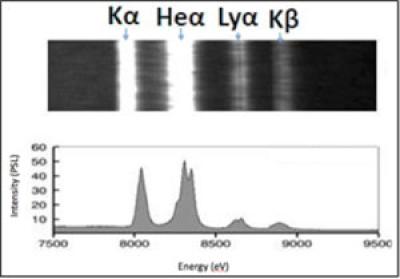Table-top Laser-driven XUV/X-ray Source
This research is aimed at understanding the fundamental parameters that control the generation of high brightness, ultra-short X-ray pulses from laser-produced plasmas. These include characteristic and continuum emissions. The invention of chirped pulse amplification (CPA) and the rapid development of high repetition rate lasers have stimulated interest in laser-driven light sources particularly in the X-ray spectral region. Although advanced light sources offer more than 10 orders of magnitude in brightness than standard x-ray tubes, they are necessarily large-scale facilities costing hundreds of millions of dollars in construction and operation. Laser-driven X-ray sources are compact and offer exceptional capability in short pulse duration.
Kα radiation, characteristic of the target material, is generated when an free electron creates a vacancy in a background atom via electron impact ionization. When an L-shell electron fills the vacancy, a Kα photon is emitted. K-shell radiation is unique to each element and the target can be chosen to generate the emission of interest.
Figure 1 shows an example of a characteristic x-ray spectrum generated by irradiating a Cu target with a high intensity laser. Clearly seen are the Kα and Kβ emission lines. In between we see the Heα and Lyα thermal lines emitted by highly ionized Cu. If monochromatic Cu Kα at 8 keV for example is needed, then a curved graphite crystal can be used to select it with only a minor loss in the signal.
Figure 1:

The Kα source size from flat targets is typically about 70 µm full width at half maximum (Figure. 2-a). It can be made bigger by defocusing the laser or smaller by using small diameter targets. Various target geometries can be used depending on the applications (Figure. 2-b and Figure. 2-c).
Figure 2:
